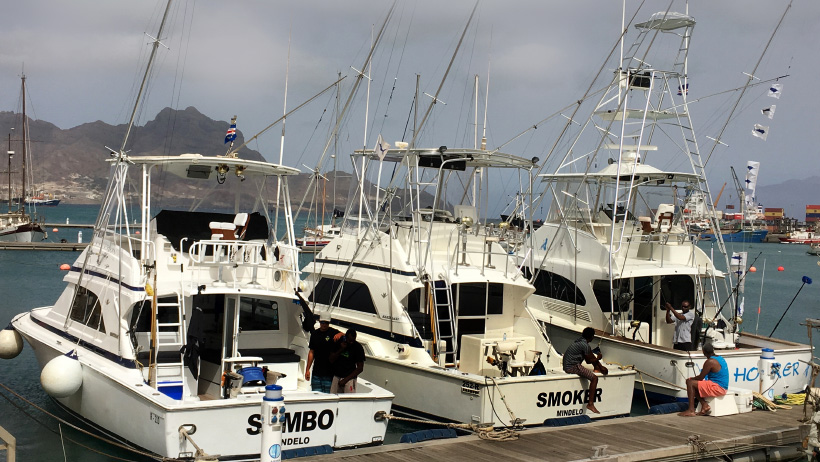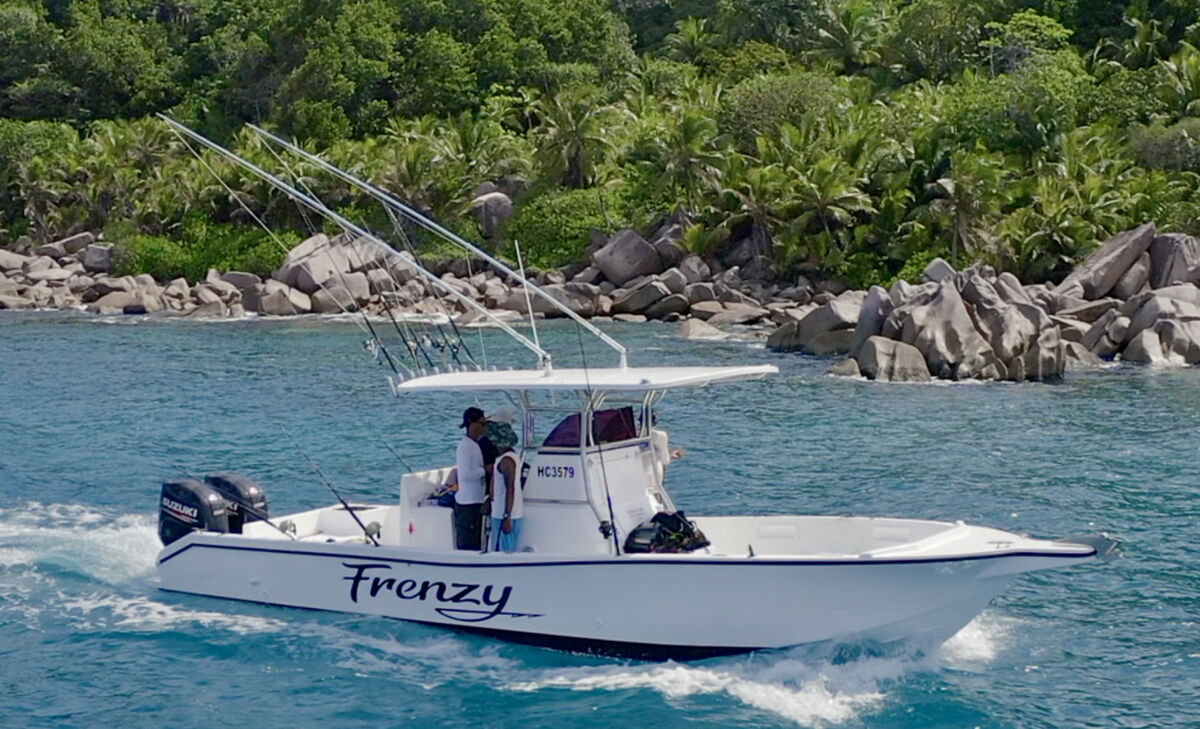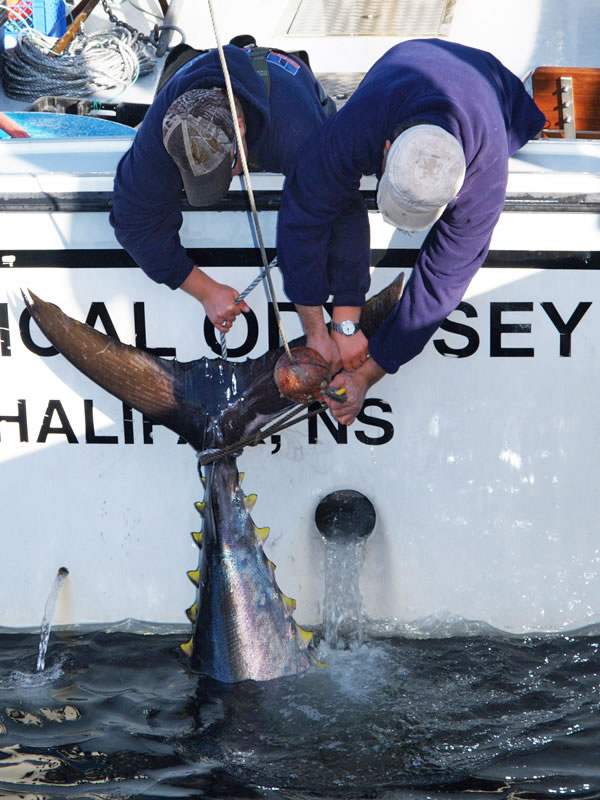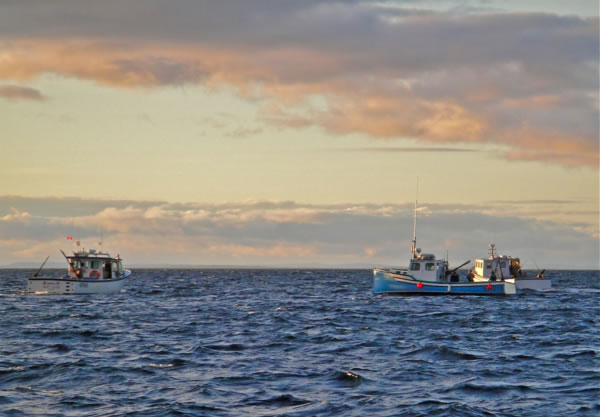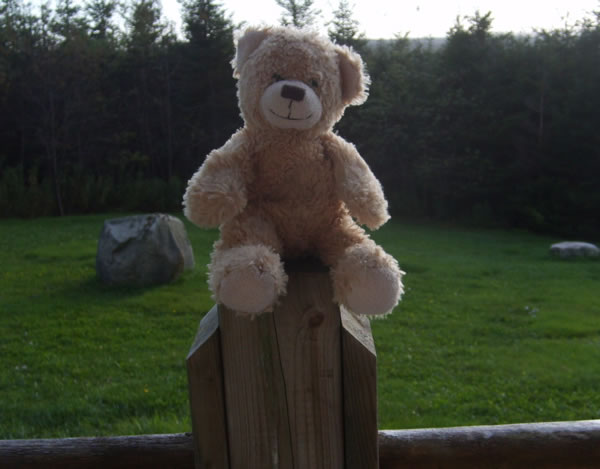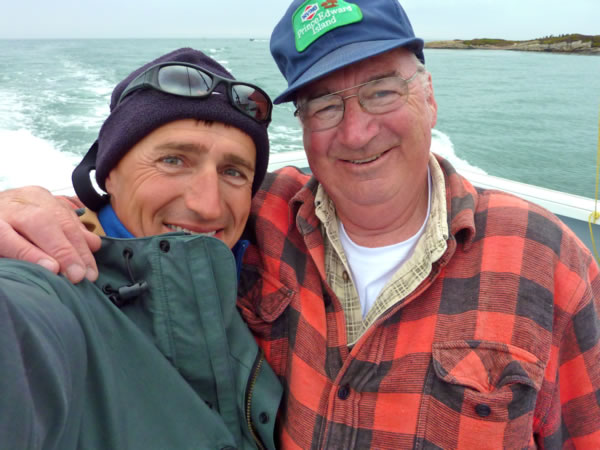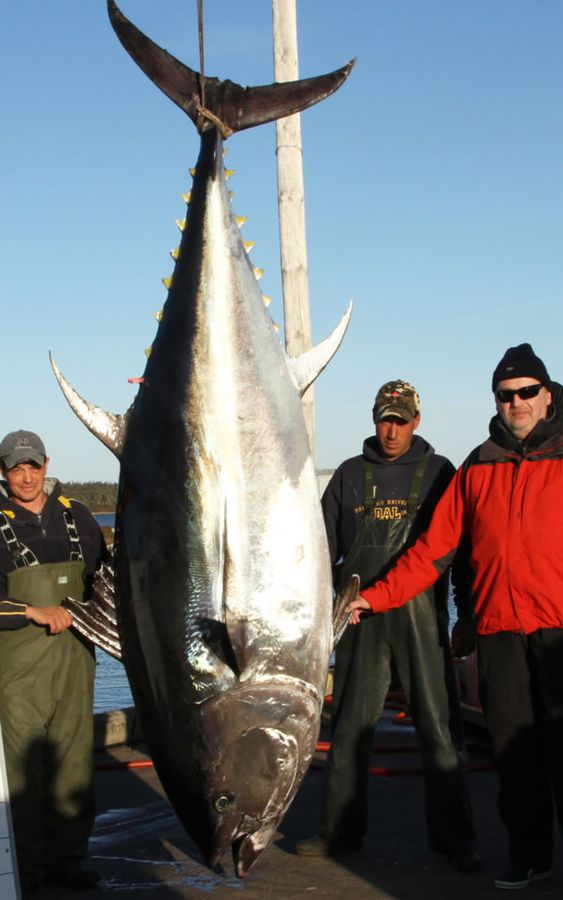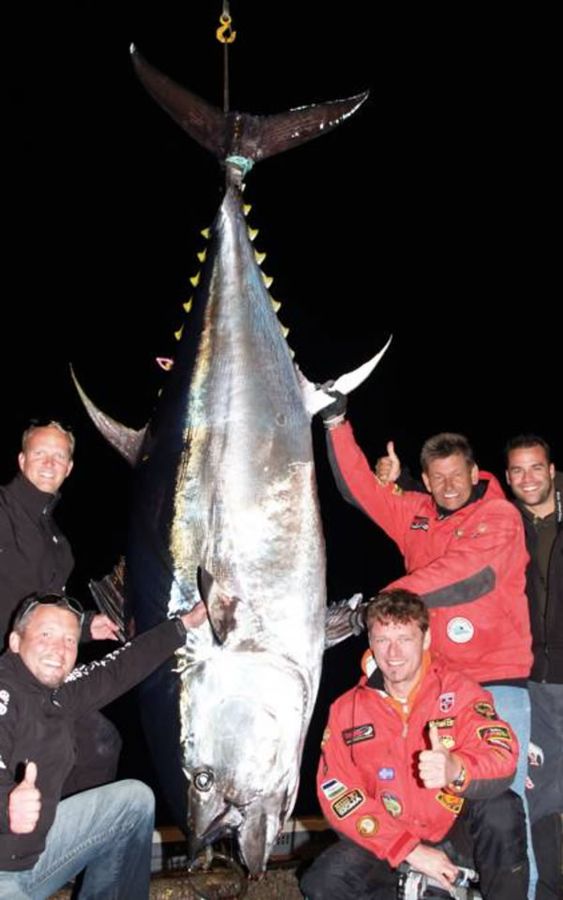Rock’n’Roll of Canso
» Fishing for Tuna in Nova Scotia 2010 «
In this report, for the sake of simplicity, we use the word ‘tuna’ when referring to the ‘bluefin tuna’. ‘Releasing’ means: setting the uninjured and live fish free. These are known as ‘C&R’. ‘Tuna Quota’ is the tonnage/number of fish allowed for consumption by the Canadian Fisheries Authority. These quotas are very strictly controlled by the Authority (by aircraft, radio messages, identification tags, spot checks at sea and a mountain of forms to be completed). As far as we could see, these regulations are kept to the letter by the Canso skippers.
On the evening October 6
four men dressed in weather-proof clothing are standing on the quayside of the Canso Marina, looking alternatively at the dark clouds passing over them and at the stormy sea crowned as far as one can see with white horses. The sound of the huge waves breaking on the offshore rocks can be heard clearly at the Marina. Even worse, there is an icy wind whistling by. Pointing to the scene, one of them says ‘Just look at it. There will be no first trip for you tomorrow’. Steve has been watching the weather forecasts for days and I have been looking at the internet satellite pictures several times a day. Unfortunately there is a storm depression on the way this means that there will be a force 6 to 8 wind with gusts up to 50 mph. ‘Believe me, even in the lobster season, our hardened captains stay at home. You lot have brought this lousy weather from Germany with you. Until shortly before your arrival we were still having an Indian summer with midday temperatures of over 20C. We smile weakly. ‘Dear Thomas, nothing doing – that comes under the provisions of the travel offer, in other words the travel agent is also responsible for the weather, and you know our subsidiary clause! No fish, no money! Thomas forces a smile. We try to cheer him up. ‘Don’t worry. This is just the luck of the sea angler and it won’t be too bad. After all, we still have nine days here and it will get better. We turn to leave. ‘Hold on. There is something else: the Canso tuna quota is unfortunately used up but probably there will be a supplement. For the time being you must release all the fish.’ We swallow hard and do not say anything so as not to depress the mood.
On the way back to our log cabin, we go over our choice of dates – early for 2010 but two weeks later than 2009, after consulting Steve and Thomas. The moon phase was right. Up till now, everything had gone smoothly: the flight on time and the journey from Halifax, as though on oiled wheels. Nobody can do anything about the weather and after all Thomas is a really nice reliable organiser of fishing holidays and a good fishing companion. And we are certain that our bad luck with the weather and the problem about the quotas have already given him sleepless nights. On top of the weather problem, two days before departure Stephan was laid low with back pain and after an injection was literally only fit to travel literally at the last minute.
These were the circumstances at the beginning of our Canso fishing trip this year. In September there had been good fish caught and sighted. Our skipper, Steve caught a 952 lb. fish at the end of September and lost a giant estimated to be 1100 lb plus directly by the boat. The other boats also caught good fish, amongst others: 800, 1008 and 1150 lb. fish, – but these were caught by professional fishermen [fighting from the mounted Gimbal in the Washboard of the Boat]. A German group only caught fish of average weight around 300 lbs (from the fighting chair) during the week before our arrival, but in adequate quantities and all the participants were delighted. It was clear that we could not expect to beat our fantastic score from 2009: 32 tuna and a blue shark. But we did not set our target too high: one or two tuna around 500 lb. and maybe a small fish with the stand-up rod.
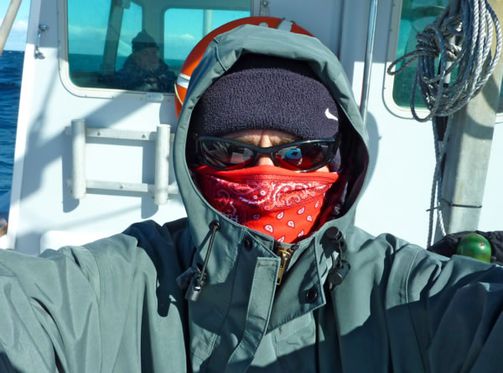
7th October
The 7th October (actually our first fishing day) was now (unfortunately) a free day. This meant that we could at least make real use of our self-drive hire car and we drove a long way on the romantic Nova Scotia highways. The countryside looks mostly like this: on one side of the highway, the stretches of seemingly impenetrable forest, on the other side, the winding seacoast with innumerable bays and small islands. All very picturesque and romantic; in our view ideal for someone who is looking for untouched landscape and isolation? For ‘townies’ and ‘sea-fishing “Junkies” such as we are, it was too untouched and quiet.
The Canadians we spoke to were (as in 2009) very friendly and helpful, but curious. Of course most of them wanted to know first of all where we came from and what had brought us at this time of year to this out- back corner of the world. Each of our new acquaintances who had a German ancestor was proud to tell us this, which we found particularly nice. Nevertheless, in spite of these pleasant meetings and the beautiful countryside, our mood became gloomier during the day. Towards 6 pm Thomas ‘phoned with the optimistic message ‘Guys, Steve is pretty sure that the wind will turn during the night, so that towards midday at the latest it will drop and the swell will be tolerable – and anyway a little rolling and cold noses should not bother you old “sea bears”, should it?’
8th October:
Finally at 7.00 we go on board the NAUTICAL-ODYSSEY with skipper Steve Meade (51), his son, Garth (19) and deckhand Donald Armsworthy ‘Duck’ (64) and out through the ‘white horses’. At sea, in the witch’s cauldron of the north Atlantic, it was all we could do in such vile conditions to get the kite and deep bait out. Remembering the old seaman’s rule ‘always hold on with one hand’, we began our longed-for ‘figure-of-eight drift fishing’.
About 10.00 without warning, a group of tuna shot horizontally out of a massive wave and attacked the kite mackerel. There was no hook-up unfortunately and the tuna disappeared as fast as they had come. Duck checked the deep bait and these mackerel had bite marks. About 3 p.m. the strong wind became a gale and we gave up – that was our first trip without a fish!
9th October:
The wind dropped a little overnight and the swell was just bearable (at least for us). The gusts kept up their biting cold. In spite of constant searching with the binoculars and moving from place to place at least ten times, this was second Day without a fish.
10th October:
Early in the day there was still a strong wind. Our hands were sore from bait-fishing and the cuts from the line between the fingers became deeper – but the morning bait fish has to be done and it is easiest and quickest with a hand line. Towards 3.30 pm we had a bite on the kite bait. It happened again without warning and was strong. The line shot way out from the reel.
Steve and Duck called simultaneously ‘maybe a big fish?‘ It was Stephan’s turn and the drill took all of 1¼ hours. We estimated the distance to the fish to be less than 20 meters. Then was a twist of the fish, the tip of the rod dipped still deeper, suddenly the rod tip whipped back. Stephan wound quickly up. ‘Sh… gone’. We discovered shortly afterwards that the tuna had bitten through just above the leader. It appeared that the sheaving gear did not slip into the fish’s mouth on the first run. Anyone who has experienced such a sudden loss after such a long drill knows how a fisherman feels and such helplessness and painful loss go right to the heart. Then the short and blunt remark from Duck and Steve: ‘maybe between 600 and 800 lb’.
Around 15.30 we had bite no. 2 on the deep bait. After 20 minutes we were able finally to land our first tuna – unfortunately only a tiny Fish of about 250 lbs which was released.
11th October:
Early in the morning the sea looked more inviting: the wind only force 3 to 4 with a few sunny spells at last. Finally, towards 2 pm we had a bite on the deep bait; after half an hour we were able to release a 300 lbs tuna. This year the smaller tunas seem to be stronger fighters – according to Steve this is due to the water being warmer for the time of year.
12th October
The 12th October was, according to Steve and Duck, the first ideal ‘tuna catching day’, but nevertheless we had no contact with fish of any kind until 2 pm; there were not even any splashes. Steve let a third rod with a herring bait drift right over the bottom. After less than a quarter of an hour: zip! A forceful bite tore the chafing gear from the rod and then there was a long run. It was Stephan’s turn again and our hopes increased from each quarter of an hour to the next that the longed-for monster would be hooked this time. After a good hour the tuna suddenly came up and we were able to gaff it securely.
It had a massive head and looked really round – at least looking at it from the railing. Duck and I estimated it to be well over 500 lb. But on the scales it weighed only 466 lb. – it must have been shorter than we thought, or was it wishful thinking?
13th October:
Setting out there was a magnificent sunrise, even short spells of sunshine and it was not quite so cold. Around 10 a.m. we saw a seagull going for our kite mackerel which it pulled out of the water with hook and leader, We tried to chase off the ‘robber’ with shouts and clapping. Frightened, the seagull then let the mackerel drop. Suddenly there was a tuna which snapped the mackerel away from the beak of the seagull as it was going for it again – was it competing for food or was it chance? After half an hour drill we released a 300 lb tuna. Around 2 pm we had another strong bite on the kite mackerel – and we were able to release this 300 pounder quickly and safely. Unfortunately the weather worsened in the afternoon. An icy northeast wind came up again and there were no more bites.
14th October:
We set off at 6 am Around 10 am after a short fight, we lost a fairly large fish again, probably because we were using a hook which was on the small side. There were no more bites. Our third day without a fish!
Each time we set off Steve became more and more on edge – there had been no big fish! Perhaps that was why he proposed for the next day: ‘Tomorrow we will start in the night! We did not mind. Our determination to catch a fish meant that one way or another we had to be the first out and the last to return. Neither were we afraid of the cold or heat, wind or waves. Our faith in fisherman’s fortune, the inestimable love of sea-fishing and our immortal hope that sometime there would be a big fish did not give any faint heartedness a chance but drove us out of our warm beds the next day (in the middle of the night).
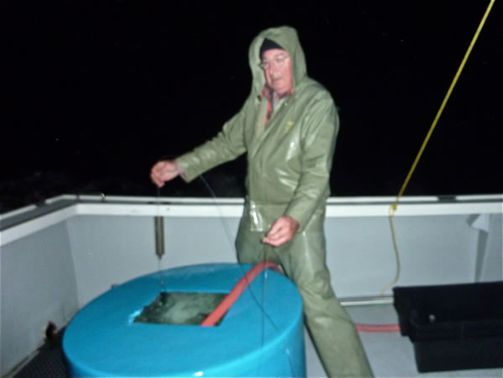
15th October:
The alarm rang at 3.45 am. We were on board before 5.00 am and set off in pitch darkness. Steve and Duck said that at last there was a southerly wind, i.e. “Canso Tuna catching wind” forecast. As soon as it was light we had the first bite, but again only a small fish!
The second bite occurred about 8.00 am. This fish was a real fighter but also only about 300 lbs. Towards 11.00 am the third bite. After three quarters of an hour drill, the hook split just 10 metres in front of the boat. Duck estimated the weight of the lost fish to be 400 lbs+. As the day progressed the south wind reached force 6 to 7 – horrible conditions for hobby fishermen like us. Steve decided to continue fishing at anchor. The NAUTICAL ODYSSEY swung considerably on the long anchor line. Great breakers kept coming over and strong gusts of wind made it difficult to maintain a steady position. At anchor we soon had two bites. Steve let the anchor line go immediately and the drills proceeded normally. We were able to find the anchor again with help of GPS and the red safety buoy without difficulty. Today was the hardest but most successful fishing day: 3 out of 3!
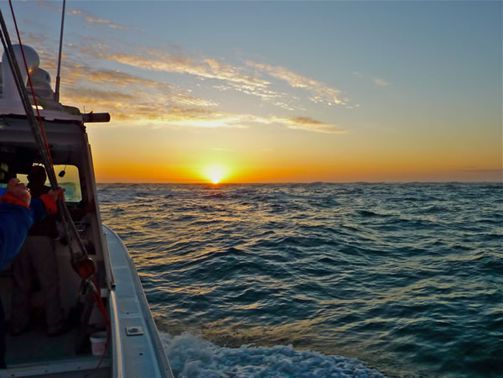
16th October:
Our last (shortened) trip and departure day. We started at about 6.30 a.m. The strong wind had died down somewhat but there was still the heavy swell of yesterday. We fished at anchor again and caught another two tuna of about 250 lb, one after another. We ended our Canso trip 2010 at about 3.30 pm. We then had to move fast to be at the airport in Halifax by 9.45 p.m. at the latest.
Epilogue:
We were unlucky in 2010. Our Canso trip 2010 ended just before the days when the giant tuna were circulating off Canso. Since we are never envious or disappointed about fishing, we heartily congratulate the successful anglers who landed the monster tuna – well done, guys!
Here are our hook-ups and catches:
| Days | Hook-Ups | Caught | Weight |
|---|---|---|---|
| 08. Oct | 0 | 0 | – |
| 09. Oct | 0 | 0 | – |
| 10. Oct | 2 | 1 | 250 lb. |
| 11. Oct | 1 | 1 | 300 lb. |
| 12. Oct | 1 | 1 | 466 lb. |
| 13. Oct | 2 | 2 | 2 x 300lb. |
| 14. Oct | 1 | 0 | – |
| 15. Oct | 3 | 3 | 250 + 2 x 300lb. |
| 16. Oct | 2 | 2 | 2 x 250lb. |
| Total | 12 | 10 |
Here are some of the beautiful photos which the proud fisherman let us have:
Our fishing friend Roman caught a monster of 975 lb. on the 20.10. The stand-up and the drill lasted 6 hours – in our opinion a magnificent angling performance.

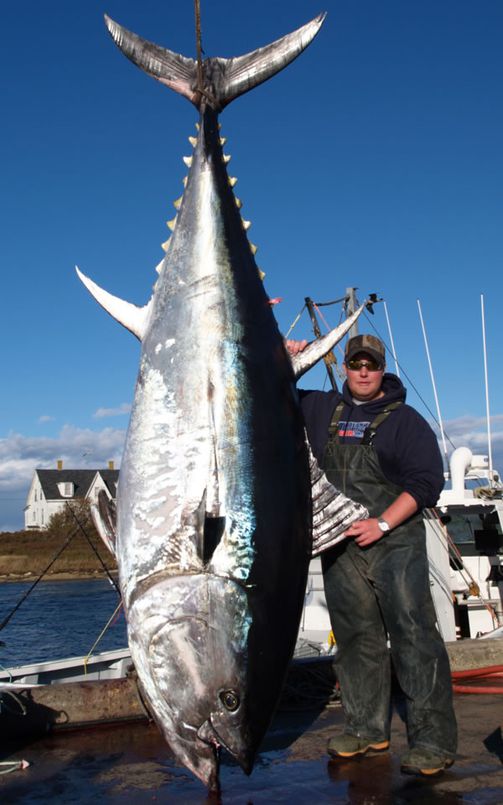
Our skipper and friend, Steve Meade went out two days after our departure with his son, Garth – Duck could not go that day. On a rather rough sea and a 40 km/h. Westerly wind, they did not have to wait long for a bite. Garth and Steve caught a tuna weighing 1025 lb. – incidentally the first big one for father and son together.
Resume:
- In our opinion Thomas Schmidt (and his girlfriend) did his very best for all his guests, whether as organiser, finding a solution to every problem, first aid helper, taxi-driver and psychotherapist for anglers.
- Dear Jocelyn and Thomas many thanks again for everything! Our thanks go of course to Bernice, Steve, Duck and Garth as well!
- Out of the ten tuna we caught, only the 466 pounder counts – and that officially and with the permission of the Canadian Fisheries Authority and the ICCAT!
- Only Circle Hooks were used on our boat and, as far as we know, on most of the other boats. Stephan and I are 100% convinced that these are the most successful and for the fish inflict less injury.
- The unpredictable quota allotment by the authorities will, in our view, always make the situation difficult for Thomas and the Canso skippers – at any rate for us hobby anglers.
- We are sure that during the current season or at latest during the next season a European or even a German sea-angler will catch a great fish from the fighting chair or even standing.
- Whoever wants to? Break the IGFA official record off Canso, should bring his own equipment with him, consult the whole project with Thomas and his crew in detail, including form-filling and organisation. Robert Rein will help as IGFA-RP and IGFA-SKIPPER with this too.
- We do not understand why physically fit hobby anglers drill their Canso tuna from the railing. Canso skippers do not allow light tackle to be used for larger tuna. We consider this is correct. Unfortunately we were not able to use our BWF-Tuna Lure test as promised because of the strong wind and the high waves.
- Every dark cloud has a silver lining – according to the proverb. In stormy seas the skilled angler should make use of the rise and fall of the swell when drilling. The angler sits safely and comfortable in his chair, at the same time the ice-cold spray cools and refreshes the reel brake.

Stephan Kreupl and Robert Rein October 2010
